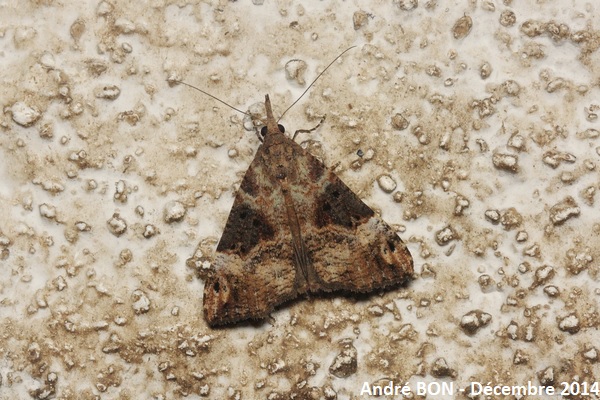
| Bloxworth Snout (Hypena obsitalis (Hübner, 1813)) |

|
|
Scientific name: Hypena obsitalis (Hübner, 1813) Common name: Bloxworth Snout French name: Hypène des ponts Order: Lepidoptera Suborder: Heterocera Family: Erebidae Subfamily: Hypeninae Wingspan: 28 to 36 mm. Biotope: Old walls, villages, rocky places. Old garages, cellars and underground cavities in winter. Geographic area: Mediterranean Basin, Near East and Middle East, North Africa south to the Sahara. Expanding northwards in western Europe, observed in the Netherlands and in the south of England. Flight time: July to August then September to October in Europe. The second brood overwinters and you may then observe it during this period. Number of generations : 2 or even more. Caterpillar: Green with a dark dorsal line and lighter coloured sub-dorsal lines. Host plant: Spreading Pellitory (Parietaria judaica) and Nettles (Urtica sp. |
The upper side of the Bloxworth Snout's fore wings varies from brown to grey. They are crosses by two dark wavy lines, outlined with a lighter colour. The area between these two lines generally shows a large triangular dark patch starting from the costal edge but without reaching the inner edge (except on very dark specimens). The second line is followed by a spot on the costal edge. This spot is white on females and grey on males. You can then see an apical spot bordered on the margin side by an oblique dark area over which you can sometimes distinguish three black tooth-shaped markings. The hind wings are blackish. The Buttoned Snout (Hypena rostralis) shows a bifid roster, it is simple on Hypena obsitalis. The tip of the fore wings draw a concave shape, it is straighter on Hypena obsitalis. |
| [To know more about the Bloxworth Snout] [Top] |

|
This moth observed during the month of December must be a member of the second brood overwintering. It chose my garage as a temporary shelter as I did not see it again after. |